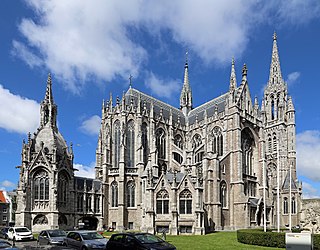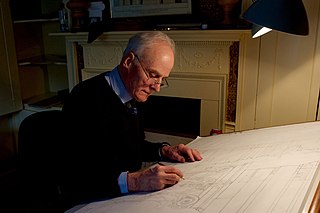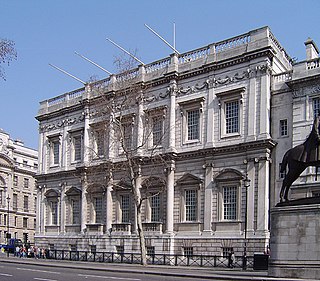This article includes a list of general references, but it lacks sufficient corresponding inline citations .(December 2022) |
John Simpson CVO (born 9 November 1954), is a British New Classical architect.
This article includes a list of general references, but it lacks sufficient corresponding inline citations .(December 2022) |
John Simpson CVO (born 9 November 1954), is a British New Classical architect.
Simpson is a member of Royal Institute of British Architects. Simpson is part of the New Classical Architecture movement of contemporary architects designing in classical styles. A profile of Simpson's design for his own house featured on the Sky Arts programme The Art of Architecture in 2019. [1]


The Doric order was one of the three orders of ancient Greek and later Roman architecture; the other two canonical orders were the Ionic and the Corinthian. The Doric is most easily recognized by the simple circular capitals at the top of the columns. Originating in the western Doric region of Greece, it is the earliest and, in its essence, the simplest of the orders, though still with complex details in the entablature above.

The Ionic order is one of the three canonic orders of classical architecture, the other two being the Doric and the Corinthian. There are two lesser orders: the Tuscan, and the rich variant of Corinthian called the composite order. Of the three classical canonic orders, the Corinthian order has the narrowest columns, followed by the Ionic order, with the Doric order having the widest columns.

Sir William Chambers was a Swedish-Scottish architect, based in London. Among his best-known works are Somerset House, and the pagoda at Kew. Chambers was a founder member of the Royal Academy.

Gothic Revival is an architectural movement that after a gradual build-up beginning in the second half of the 17th century became a widespread movement in the first half of the 19th century, mostly in England. Increasingly serious and learned admirers sought to revive medieval Gothic architecture, intending to complement or even supersede the neoclassical styles prevalent at the time. Gothic Revival draws upon features of medieval examples, including decorative patterns, finials, lancet windows, and hood moulds. By the middle of the 19th century, Gothic Revival had become the pre-eminent architectural style in the Western world, only to begin to fall out of fashion in the 1880s and early 1890s.

Sir John Soane was an English architect who specialised in the Neo-Classical style. The son of a bricklayer, he rose to the top of his profession, becoming professor of architecture at the Royal Academy and an official architect to the Office of Works. He received a knighthood in 1831.
The year 2002 in architecture involved some significant architectural events and new buildings.

John Quinlan Terry CBE is a British architect. He was educated at Bryanston School and the Architectural Association School of Architecture. He was a pupil of architect Raymond Erith, with whom he formed the partnership Erith & Terry.

The King's Gallery, previously known as the Queen's Gallery, is a public art gallery at Buckingham Palace, the official residence of the British monarch, in London. First opened to the public in the reign of Elizabeth II in 1962, it exhibits works of art from the Royal Collection on a rotating basis. Enlarged in the early 21st century, the gallery has its own separate public access entrance built in a 'new' classical style and typically displays about 450 works, mainly paintings and drawings.

London's architectural heritage involves many architectural styles from different historical periods. London's architectural eclecticism stems from its long history, continual redevelopment, destruction by the Great Fire of London and The Blitz, and state recognition of private property rights which have limited large-scale state planning. This sets London apart from other European capitals such as Paris and Rome which are more architecturally homogeneous. London's architecture ranges from the Romanesque central keep of The Tower of London, the great Gothic church of Westminster Abbey, the Palladian royal residence Queen's House, Christopher Wren's Baroque masterpiece St Paul's Cathedral, the High Victorian Gothic of The Palace of Westminster, the industrial Art Deco of Battersea Power Station, the post-war Modernism of The Barbican Estate and the Postmodern skyscraper 30 St Mary Axe 'The Gherkin'.

Sir Colin Alexander St John ("Sandy") Wilson, FRIBA, RA, was an English architect, lecturer and author. With his partner MJ Long, Wilson spent over 30 years progressing the project to build a new British Library in London, originally planned to be built in Bloomsbury and now completed near Kings Cross.

David John Watkin, FRIBA FSA was a British architectural historian. He was an emeritus fellow of Peterhouse, Cambridge, and professor emeritus of History of Architecture in the Department of History of Art at the University of Cambridge. He also taught at the Prince of Wales's Institute of Architecture.

The Banqueting House, on Whitehall in the City of Westminster, central London, is the grandest and best-known survivor of the architectural genre of banqueting houses, constructed for elaborate entertaining. It is the only large surviving component of the Palace of Whitehall, the residence of English monarchs from 1530 to 1698. The building is important in the history of English architecture as the first structure to be completed in the classical style of Palladian architecture which was to transform English architecture.

The University of Notre Dame School of Architecture was the first Catholic university in America to offer a degree in architecture, beginning in 1898. The School offers undergraduate and post-graduate architecture programs.

Sir John William Simpson KBE FRIBA was a British architect and President of the Royal Institute of British Architects from 1919 to 1921.

Alexander "Sandy" Stoddart is a Scottish sculptor, who, since 2008, has been the Queen's Sculptor in Ordinary in Scotland and is now the King's Sculptor in Ordinary. He works primarily on figurative sculpture in clay within the neoclassical tradition. Stoddart is best known for his civic monuments, including 10-foot (3.0 m) bronze statues of David Hume and Adam Smith, philosophers during the Scottish Enlightenment, on the Royal Mile in Edinburgh, and others of James Clerk Maxwell, William Henry Playfair and John Witherspoon. Stoddart says of his own motivation, "My great ambition is to do sculpture for Scotland", primarily through large civic monuments to figures from the country's past.
Rick Mather was an American-born architect working in England. Born in Portland, Oregon and awarded a B.arch. at the University of Oregon in 1961, he came to London in 1963 and worked at the architectural firm Lyons Israel Ellis for two years. He became a leading figure at the Architectural Association in the 1970s, and in 1973 founded his own practice, Rick Mather Architects.
The year 2013 in architecture involved some significant architectural events and new buildings.

New Classical architecture, New Classicism or Contemporary Classical architecture is a contemporary movement in architecture that continues the practice of Classical architecture. It is sometimes considered the modern continuation of Neoclassical architecture, even though other styles might be cited as well, such as Gothic, Baroque, Renaissance or even non-Western styles – often referenced and recreated from a postmodern perspective as opposed to being strict revival styles.

Bond Hall is a building on the campus of the University of Notre Dame which hosts student learning initiatives and a number of institutes including the Graduate School. It was originally built in 1917 as the Lemmonier Library and it housed the Notre Dame School of Architecture from 1964 to 2019. The architect was Edward Lippincott Tilton, a neoclassical architect who specialized in libraries. Its front steps are famous as the location of the Notre Dame Marching Band performances before the football games.

The Walsh Family Hall of Architecture is a building on the campus of the University of Notre Dame and houses of the Notre Dame School of Architecture. Construction started in 2016 and was completed in 2019. The school was previously hosted in Bond Hall. Designed by John Simpson, it is an example of New Classical architecture, for which the School of Architecture is well known for. The complex features a Greek-architecture inspired Hall of Casts, a stoa, a tower and a courtyard. The building design won several awards for its design.